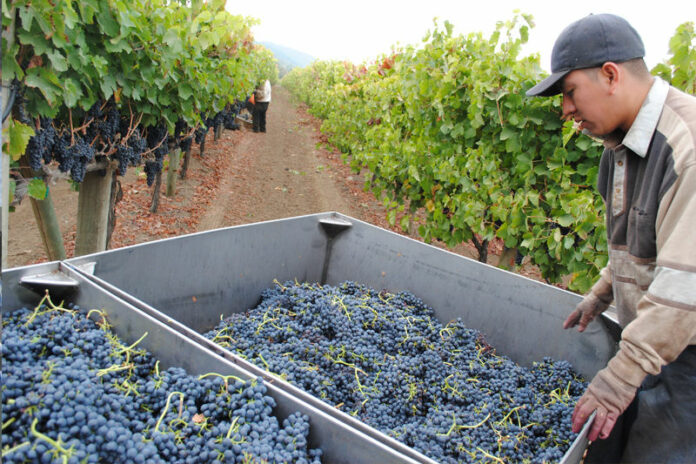Official 2016 report released as new harvest begins
A high apple and wine grape yield boosted last year’s crop season, making it worth nearly $900 million. The overall value represents a 17 percent jump over the 2015 season, as stated in the 2016 Sonoma County Crop Report, released Tuesday to the Sonoma County Board of Supervisors.
The winter’s heavy rains — with six inches falling December 2015 and another 14 inches drenching the county in January and March, significantly helped crop yields, according to Tony Linegar, the county’s agricultural commissioner.
The paper report and bureaucratic filing of the 2016 report coincides with some real crop action this week, as the local Gravenstein apple harvest moved into full speed and with the earliest grape pickings expected to happen this week as well.
The local apple crop was stacked sky-high in bins at Manzana Products in Graton as farm trucks kept the weigh scale busy.
Local grower Mike Meyer Jr. said the apple crop looks very good. “We’re just getting started and we expect a good, long season.”
The 2016 apple yield increased 46 percent over the dismal 2015 apple season, Linegar said. The value of fresh apples actually decreased from 2016 but processed apples, which includes canned apples, juice, cider and vinegar sales, were valued at $4,755,000 compared to 2015’s $3 million value. The Gravenstein apple, near and dear to the county’s heart, more than doubled its output last year from 2,275 tons to 4,730 tons, bringing prices and overall revenue down. Despite the increased production, overall value for the Gravenstein only rose by about $300,000 to a total $1,595,000. A trend of the past decade shows a decline in apple production. The fruit peaked in 2007, 2008 and again in 2011. However, since the drought, production has been nearly half its previous years, with the 2014 and 2015 seasons faring the worst.
Wine grapes, which are the county’s primary crop, saw an increase in both tons crushed and price per ton, leading to an overall wine grape increase of nearly $140 million, roughly 24 percent over 2015 values.
Red varietals were valued at $392,910,600, almost $100,000,000 more than the previous year. White varietals were worth $586,517,700 this year, roughly $120,000,000 more than last year. The season was more in line to production values seen in 2012 through 2014.
Vegetable crops, including crucifers, squash, melons, mushrooms, potatoes, peppers, tomatoes, sprouts and lettuces, lost about $2.5 million over the 2015 season, bringing in $9.96 million. Field crops, however, which include hay, rye, oat, barley, safflower and wheat, increased in value by more than $1 million to total $13.7 million in 2016. Total apiary products, which include honey, wax and hives, also increased over 2015, more than doubling production value to bring in $263,200.
Overall livestock values decreased, mainly due to a value loss for cattle and calves over the 2016 season, which brought in $20.5 million, a $1.5 million loss over 2015. Sheep and lamb prices and counts were up to $8.5 million, helping make up the loss from cattle.
Fishermen, especially crabbers, were more successful in 2016. Dungeness crab, which had a longer season than the 2015 season tainted with Domoic Acid poisoning, was valued at $12.2 million, more than 10 times the 2015 value. Chinook were slightly up, bringing in $790,271, a value still grossly low from average fishing seasons.
47.6
F
Healdsburg
April 21, 2025








